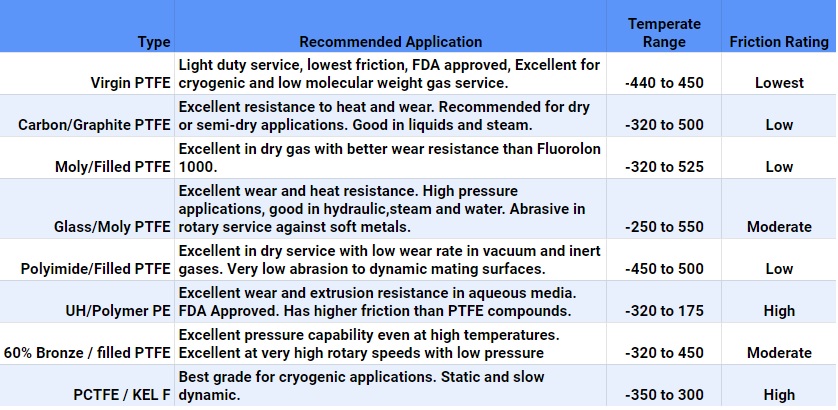The ability of cryogenic seals to maintain integrity is often critical not just for the processes involved but for the safety of humans, other equipment, and the environment. Seal failure could lead to expensive damage, hefty lawsuits, and even loss of life. Finding reliable solutions that can handle cryogenic temperatures and the pressures involved is challenging but not impossible.
Cryogenic Valves
Cryogenic valves are used with media that is at or below freezing and can include chemicals such as Liquid Helium, Liquid Hydrogen (LH2), Liquid Natural Gas (LNG), Liquid Nitrogen (LN2), and Liquid Oxygen (LOX). Processing and transportation of such chemicals involve the use of valves requiring highly reliable seals and/or O-rings to keep the media uncontaminated and prevent it from escaping from the system.
Challenges to achieving a dependable seal for cryogenic valves include factors such as
- The ability to maintain flexibility at extremely low temperatures
- Good performance at the pressures associated with cryogenic performance
- Extensive chemical compatibility
- Low friction, minimal stick-slip behavior, and self-lubrication
PTFE Spring Energized Seals for Cryogenic Valves
One of the most popular solutions for achieving a solid seal in cryogenic valves is PTFE spring-energized seals.
Spring-Energized Seals
Spring energized seals are different from more traditional sealing solutions in that they use a combination of system pressure and spring energizers to achieve a highly reliable seal. When high operating pressures are involved, the pressure of the media can usually keep the seal lip in contact with the mating surface. At the same time, the springer-energizer then takes over for high pressures and accommodates issues such as misalignment, eccentricity, and wear on the seal lip. On the other hand, when used in applications involving low operating pressures, the spring energizer maintains the seal lip in contact with the sealing surface at all times.
PTFE
For cryogenic applications, spring energizes seals with a jacket material of filled/unfilled PTFE is often recommended. PTFE (also known by its trade name Teflon) is known for its extremely low friction, self-lubricating properties, and performance over a wide range of temperatures. This engineering polymer also offers outstanding chemical compatibility, good dimensional stability, and no water absorption. In addition, there are PTFE grades that are FDA approved for use with food, beverage, dairy, and pharmaceutical applications. Also, note that there are several different grades of PTFE that are available for cryogenic service, with minimum operating temperatures beginning at -450°.
Helical Spring Energizers
The choice of spring energizer is critical, which the most common spring configurations being canted coil springs, V springs, helical springs, cantilever springs, and continuous contact springs. Of these, helical springs are highly recommended for cryogenic applications.
Helical springs, also known as flat springs or compression springs, take the form of a wound ribbon of metal wrapped in a coil that resembles a screw thread. Their geometry leads to a high load versus displacement cure, leading to a small deflection range that supports excellent seal integrity when high pressures and vacuum pressures (which often go hand-in-hand with cryogenic temperatures) are involved.
Some of the most common spring energizer materials are summarized below.
FEP Encapsulated Helical Springs for Cryogenic Valve Seals
Another excellent option for cryogenic valve seals is FEP encapsulated O-ring, or, more specifically, FEP encapsulated helical springs. While basically like an O-ring, it combines the outstanding properties of FEP Teflon with the reliability of a spring-energizer. And, unlike other encapsulated O-rings on the market, FEP encapsulated helical springs have an energizing helical wound spring at the core rather than a hollow or elastomeric core. And FEP encapsulated helical springs work exceptionally well in cryogenic environments.
And the ability of FEP encapsulated helical springs to fit almost all standard AS568 O-Ring gland sizes means that engineers can design around a standard O-Ring glad design.
One of the key aspects of FEP encapsulated O-rings is the ability to use an energizer that would be subject to chemical attack if it were not for the encapsulating material. FEP (fluorinated ethylene propylene) is often known by tradenames such as Teflon FEP, Neoflon FEP, and Dyneon FEP. It has many characteristics and properties that make it ideal for cryogenic applications, such as the ability to remain flexible at cryogenic temperatures as low as -420°F. It also exhibits a very low compression set, a low coefficient of friction, minimal stick-slip behavior, and the ability to self-lubricate. And, like PTFE, FEP is available in FDA-approved grades and is highly resistant to chemical attacks.
Unlike PTFE, FEP exhibits lower levels of gas and vapor permeability, which is often critical for specific applications. It is also melt-processable, making it much easier to injection mold, extrude, or vacuum form.
Note that the previous section dealing with helical springs, detailing their benefits for spring-energized seals, is equally applicable to FEP encapsulated O-rings.
Conclusion
Both PTFE spring-energized seals and FEP encapsulated helical springs meet the essential requirements for cryogenic valve seals: the ability to maintain flexibility at extremely low temperatures; extensive chemical compatibility; good performance at the pressures associated with cryogenic performance; and low friction, minimal stick-slip behavior, and self-lubrication.
If you are looking for a high-quality, highly reliable sealing solution for cryogenic valves, contact Advanced EMC today.


